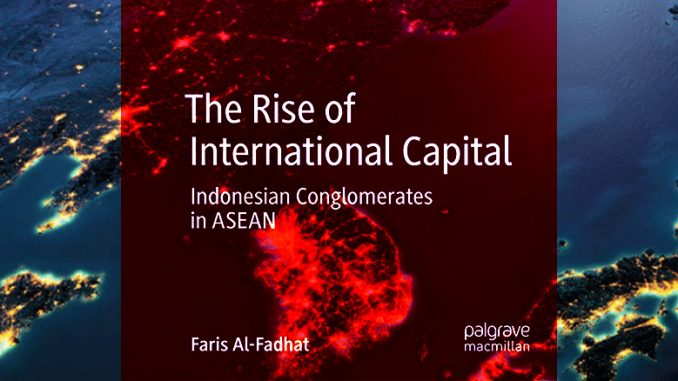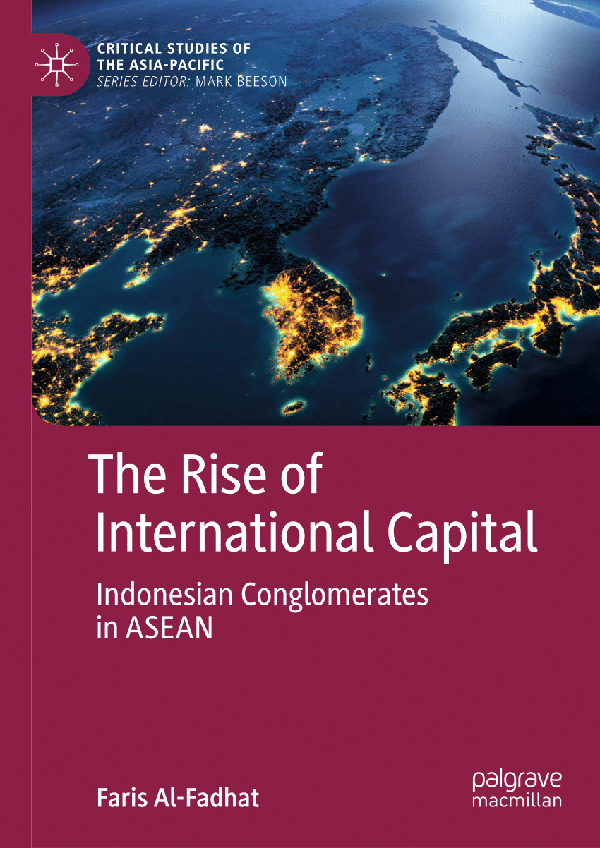
Title: ASEAN and The Intensification of Regional Cooperation: Class Formation and Internationalized Capital
Author: Al-Fadhat, Faris
Palgrave McMillan, 2019
Economic Regionalism, ASEAN, and IR Theories
Since its establishment and further development, ASEAN, a regional organization, has experienced various modifications. In IR studies, ASEAN is frequently depicted as anomaly because it could not be fit by mainstream paradigms in IR such as realism and liberalism. In my opinion, although Faris Al-Fadhat does not necessarily address this particular issue, this book attempts to transcend and propose more relevant frameworks to understand ASEAN as an economic regionalism. Thus, generally, the basic idea of this book aims to explain the origin of ASEAN and the development of its further economic modification.
In explaining ASEAN, in the second and the third chapters of this book, Faris compares his conceptual framework with other existing IR frameworks. He particularly points out on how realism and liberalism have given their respective explanation regarding the origin of ASEAN and its development. Realism argues that the origin of ASEAN is fundamentally related to the state’s internal drive to survive in the international politics. It is indeed that ASEAN’s countries have developed certain kinds of cooperation. However, as realists argue, the crucial motive and drive are the state’s self-centered. This particular argument mainly refers Cold War as the geopolitical background of ASEAN establishment. In its further development, every modification and ASEAN regional policy is observed as balancing policy which aims survival in the realm of international politics. Meanwhile, the liberal approach argues that the real drive of regional organization is dominantly a functional drive to cooperate. While domestic’s problems of one state become increasingly internationalized, it is a rational choice for one state to cooperate and initiate regional cooperation. In the ASEAN context, liberalism always uses this kind of rational drive as the basic tenet for the creation of ASEAN Economic Community and thus creating more intensive interdependent intra-state relations. However, these two approaches also have fundamental weaknesses. First, they assume state as unitary with solid and integrated interest. Second, central to realism is its weakness to capture the increasingly complex interdependent relations among ASEAN states. While liberalism naively ignores the latent conflicts and even competitions between some states in ASEAN. These fundamental problems are the consequence of their basic theoretical assumption. Thus, the way to transcend these problems could not be done by using the same frameworks.
Internationalization of Capital and State: The Alliance of International Capitalist and Elite Politics
 In transcending those problems, Faris proposes his own framework which mostly derives from Marxist perspective. On my observation, most of his concepts ground on Marxist conceptualization of the relation of state and capitalism. Succinctly, this relation could be defined as supportive relation where state and capitalism need each other for its existence and development. Based on this assumption, Faris attempt to develop his own framework. Firstly, he notes the tendency of capitalism to always internationalize its system. Quoting Marx, capitalism has always been had a tendency ‘to tear down every spatial barrier to intercourse, to exchange, conquer the whole earth for its market, it strives on the other side annihilate this space with time i.e. to reduce to a minimum the time spent in motion from one place to another.’ In this process, three factors interplays significantly, namely expansion of production, commodity, and money circuit. At the end, this overall process create a condition in which commodity could only be produced and realized in the global scale.
In transcending those problems, Faris proposes his own framework which mostly derives from Marxist perspective. On my observation, most of his concepts ground on Marxist conceptualization of the relation of state and capitalism. Succinctly, this relation could be defined as supportive relation where state and capitalism need each other for its existence and development. Based on this assumption, Faris attempt to develop his own framework. Firstly, he notes the tendency of capitalism to always internationalize its system. Quoting Marx, capitalism has always been had a tendency ‘to tear down every spatial barrier to intercourse, to exchange, conquer the whole earth for its market, it strives on the other side annihilate this space with time i.e. to reduce to a minimum the time spent in motion from one place to another.’ In this process, three factors interplays significantly, namely expansion of production, commodity, and money circuit. At the end, this overall process create a condition in which commodity could only be produced and realized in the global scale.
However, this process will be impossible without political process, quoting Hannah Arendt, which is called accumulation of power. This refers to the urgent role of political structure—whether it is a state, regional, or global institution—which has unlimited power to regulate and guarantee the never ending process of capital accumulation and the cycle of capital circuit. Every regional economic initiatives, argue Faris, should be analyzed with this assumption.
Nevertheless, the overall process above could not be assumed as teleological and functional process. Rather than that, the historical, material, and dialectical process should be carefully used. In this context, Faris highlight the crucial definition of state, just like any Marxist approach, as a never ended conflictive area which is contested domestically among specific social groups. Faris argue that central actors to this contestation are capitalist class and elite politics. Nonetheless, the internal interests between capitalist classes and the elite politic are not always congruent. Theoretically, Faris classify capitalist class into several categories based on their scale of capital accumulation in global market. The classifications are international capitalist, investment-constrained capitalist, market-constrained capitalist, and national capitalist. In the case of economic regionalism, international capitalist—with its international capacity of investment, production, and commodity—has the most ambitious interest in developing economic regionalism. How these social groups succeed in promoting their interest are the matter of historical dialectical process. Thus, Faris highlight the urgency to trace its historical origin domestically. In other words, succinctly, in ASEAN case, hypothetically, Faris propose that the actual drives of ASEAN establishments are capitalism and the role of state to facilitate those drives. Faris analysis next, thus, is an attempt to prove this framework.

The Origin of ASEAN and Intensification of Regional Cooperation: Class Formation and the Internationalization of Capital
Dominantly, the ASEAN establishment is deemed solely political. This assumption refers to the Cold War condition which became the background of the ASEAN establishment. Consequently, this process can be described as a top-down rather than a bottom-up process. Nonetheless, this narration ignores the domestic process of Southeast Asian states during that time. In Indonesia for example, the initiative to establish ASEAN emerged only after Soeharto’s regime came to the power. His regime was well known as anti-communist. He succeeded in destroying the leftist movement and became authoritarian. Meanwhile, in the Philippines, the Marcos regime shared many similarities with Indonesia. It is noteworthy to highlight that at the start the ASEAN charter generally stressed the importance of creating a political stability for the state’s developmental programs. These were fundamental interests of the capitalist class in ASEAN. Furthermore, given that at the initial process most of the capitalist classes in Southeast Asia were dominantly sustained by the state, this fact could not be more surprising.
In its further development, regional cooperation and intra-trade cooperation could only intensify intensively after 1999. The initial initiative for creating a free trade area in Southeast Asia surely started in 1977 in the form of the Preferential Trade Agreement (PTA). Nevertheless, most of the member states faced difficulties to build the same interest and agreement. Central to this fact were the class formations and their interests. Malaysia and Indonesia were not supportive of this idea. The roots of their unsupportive acts were their development models which gave central and dominant privileges to their domestic capitalists. Thus, class formation and the development of capitalism play crucial roles in affecting the initiative of regional economy cooperation. Faris argues that the intensification of regional economic cooperation in ASEAN after 1999 had a strong connection with the fundamental change of class formation and capitalism of ASEAN’s member states. The crisis on 1999 compelled several ASEAN states to open their domestic market. Consequently, the state’s roles to protect domestic market decreased significantly, which also meant the reduction of the state’s protection on domestic capitalist class. Further, the impact also crucially caused the changes of the development model, political system, and most importantly accumulation capital model of domestic capitalist class. Faris names this phenomenon as the rise of international capital.
In explaining this phenomenon, Faris generally explains the capitalism development in several countries in ASEAN such as Thailand, the Philippines, and Malaysia. He specifically studies Indonesia’s case. Particularly, he highlights one conglomerate from Indonesia, the Salim Group. During 1995-1996, the Salim Group companies dominantly operated in Indonesia; 71 percent domestically, 25 percent internationally, and the rest was at best mix. During the financial crisis, the Salim Group experienced a great loss as the impact of price fluctuation and the state’s support increasingly diminished. The Salim Group’s new chairman, Anthony Salim, responded to this by readjusting the Salim market operation: 50 percent in Indonesia and 50 percent outside of Indonesia. By doing this, the dependence toward the Indonesian government would be decreased while at the same time it still maintained Indonesia as its biggest market. Hence, this change in the capital accumulation allowed the Salim Group to aggressively encourage the regional cooperation in ASEAN. Practically, it was also accompanied by its domestic maneuvers in which they captured several strategic spaces in the state. Most of them were indirect maneuvers. It could cooperate with influential politicians in the economic sector or make them their commissioner. On the one hand, the whole process could beneficially generate a political impact toward the Salim Group’s domestic access. On the other hand, it could also give them more space to encourage the state to support the regional cooperation through ASEAN.
Conclusion
Generally, the main argument of this book is the significance of the change of capital accumulation and class formation toward ASEAN intensive regional economic cooperation. Central to this argument is the internationalization of capital of the capitalist class in the ASEAN member states. To ensure the certainty and the assurance, the regional regulation should be created. With this explanation, this book has successfully offered a more adequate explanation on ASEAN’s origin and economic policy. Consequently, this book is highly recommended for those who are interested in regionalism and Southeast Asian studies.
Nandito Oktaviano
Nandito Oktaviano is a freelance writer with an interest in international political economy, geopolitics, religion and politics, and racism.
